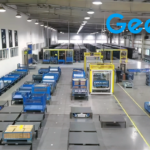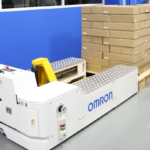ASIA ELECTRONICS INDUSTRYYOUR WINDOW TO SMART MANUFACTURING
Factories Bank on NVIDIA Tech Workflow for Better DX
Electronics manufacturers and automation companies are working double time to ensure a fully integrated and seamless smart manufacturing. For that reason, NVIDIA Founder and CEO Jensen Huang underscored how manufacturers are employing the company’s technologies to enable autonomous factories.
In his keynote speech Sunday night ahead of Computex, Huang said dozens of electronics manufacturers and automation providers are showcasing NVIDIA software and tools in automation production. Specifically, he noted how a workflow that combines workflow combines NVIDIA Metropolis vision AI, NVIDIA Omniverse™ physically based rendering and simulation, and NVIDIA Isaac™ AI robot development and deployment.

“By using the workflow to build digital twins for real-time simulation of different factory layouts, manufacturers can optimize space, processes and efficiency without costly physical changes,” said Huang.
Crucial Role of Generative AI, Digital Twin
The NVIDIA CEO said manufacturers are seeing a need to turn factories into autonomous machines amid the increasing challenges in production. Thus, generative AI and digital twins are crucial to make smart manufacturing a reality. For one, AI can drive large language models to boost floor productivity. ON the other hand, Huang cited digital twins to help manufacturers simulate and develop factories and AI-powered automation prior to deployment in real factories.
He said NVIDIA Omniverse and Metropolis help to build digital twins for factories, planning efficiency optimizations and worker safety improvement at a number of manufacturing sites.
At COMPUTEX, several companies are using NVIDIA’s reference workflow to build, simulate, and operate their robotics-enhanced facilities.
For example, Huang noted how Foxconn, one of the world’s largest electronics manufacturers, develops digital twins of its factories on NVIDIA Omniverse. Specifically, this platform allows virtually integrating 3D data from leading industry tools such as Teamcenter from the Siemens Xcelerator platform.

Omniverse helps Foxconn’s teams optimize equipment layout for operational flow and AI cameras to monitor worker safety with NVIDIA Metropolis. Thereafter, Foxconn can use the factory digital twins as virtual training environments. Particularly, to simulate, test, and validate its autonomous mobile robots (AMRs) built on NVIDIA Isaac Perceptor acceleration libraries. Meanwhile, NVIDIA Isaan Manipulator AI models can program AI robot manipulation arms.
Several other companies have adopted the NVIDIA reference flow in enhancing their respective production floors.
Robotics in Factories
Global electronics giants are integrating NVIDIA’s autonomous robotics into their factories. Thus, leveraging simulation in Omniverse to test and validate this new wave of AI for the physical world. This includes over 5 million preprogrammed robots worldwide.

“All the factories will be robotic. The factories will orchestrate robots, and those robots will be building products that are robotic,” Huang explained.
Huang emphasized NVIDIA Isaac’s role in boosting factory and warehouse efficiency, with global leaders like BYD Electronics, Siemens, Teradyne Robotics and Intrinsic adopting its advanced libraries and AI models.
NVIDIA AI Enterprise on the IGX platform, with partners like ADLINK, Advantech and
“The era of robotics has arrived. Everything that moves will one day be autonomous,” said Huang. In addition, he said, “We are working to accelerate generative physical AI by advancing the NVIDIA robotics stack, including Omniverse for simulation applications, Project GR00T humanoid foundation models and the Jetson Thor robotics computer.”
Moreover, Huang added, “Robotics is here. Physical AI is here. This is not science fiction, and it’s being used all over Taiwan. It’s just really, really exciting.”
03 June 2024




